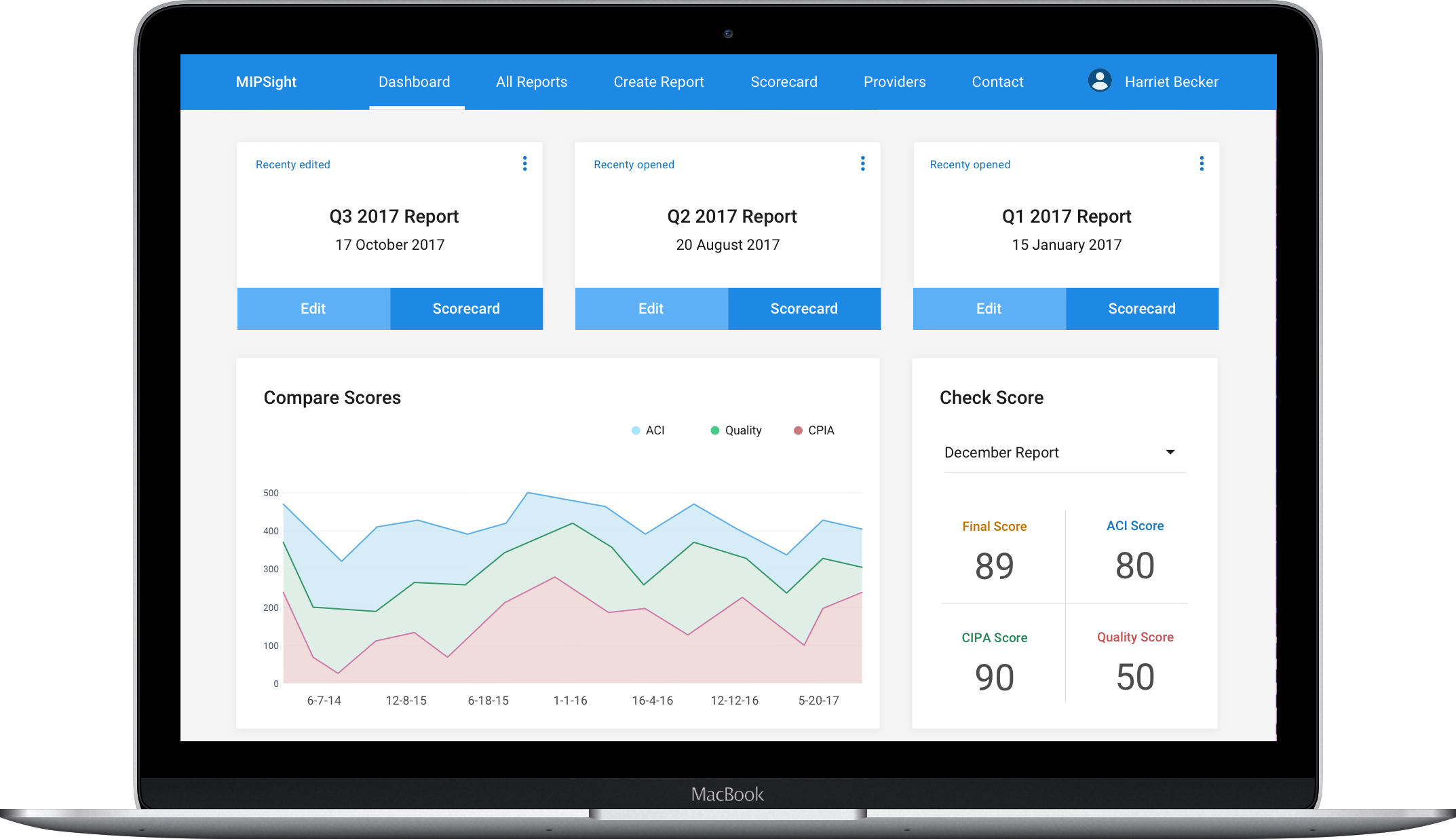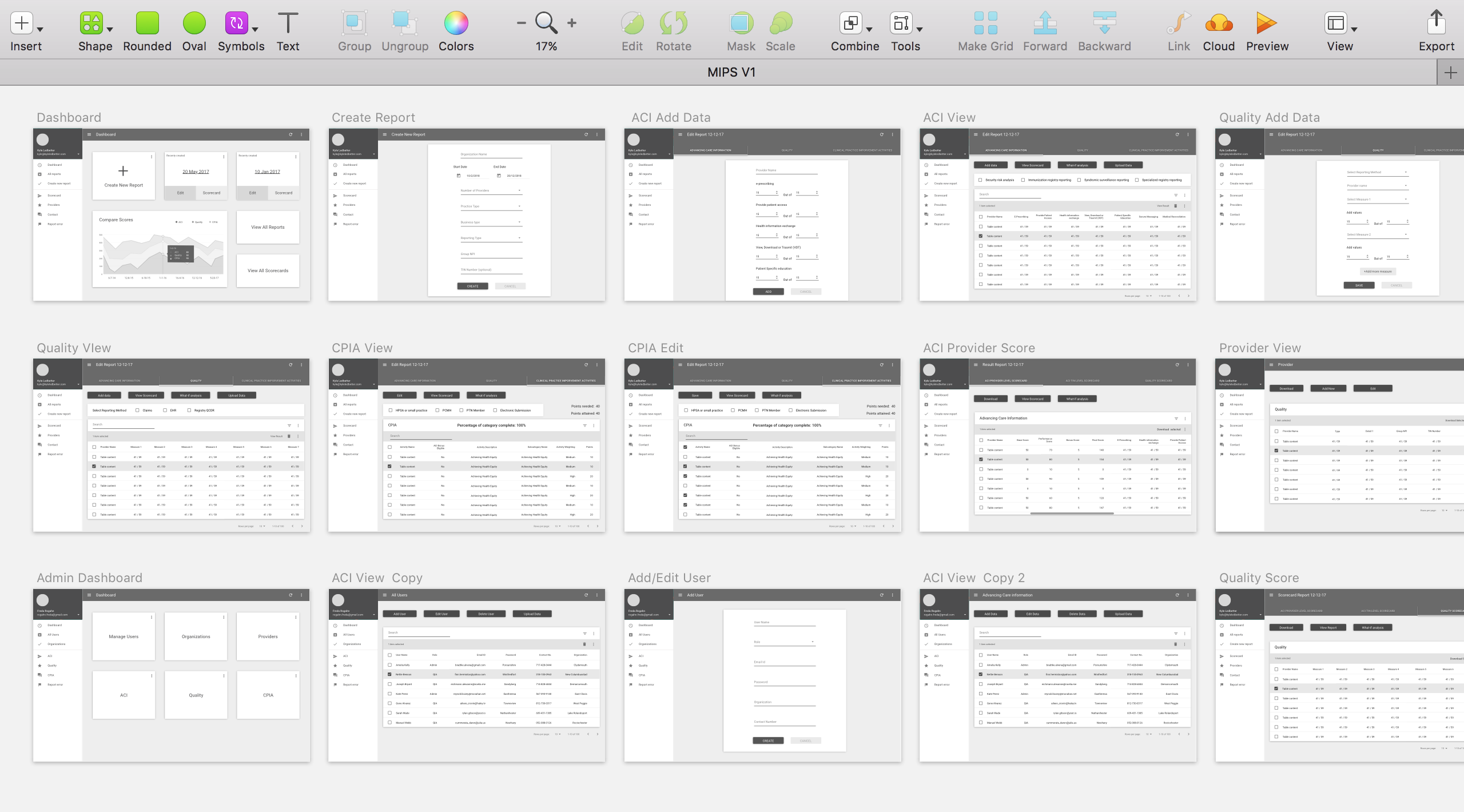The Solution
MIPSight Web App
A customizable web based application which can record data, generate scorecard and conduct what-if analysis to save time and provide meaningful insights.

The Merit-based Incentive Payment System (MIPS) is a new way by which eligible clinicians will be measured by U.S. Dept. of Health Services to determine if they are providing quality patient care in an economically efficient way.
Regenstrief Institute wanted to build an online platform for physicians & healthcare advisors to report & track performance efficiently thereby decreasing administrative burdens.
My Role:
User Research, Interaction, Visual design, Prototyping & Testing
Duration:
April'17 - September'17
MIPSight Web App
A customizable web based application which can record data, generate scorecard and conduct what-if analysis to save time and provide meaningful insights.


1. Dashboard
A dashboard which shows all the important & frequently used features at one place to navigate faster. Users can quickly view, edit and compare scores from different reports.
2. Manage Reports
All the reports are saved and organized automatically by the date created. Users can search sort and filter the reports based on their date, score and edit history.


3. View Report
In these individual reports, users can add, edit, search, and import data in the tables. They can also generate scorecards of the reports in real time.
4. Scorecard
A scorecard visualizes the report to show meaningful insights such as indivual performance, top providers, and overall score which can be downloaded anytime by the users.

The users of this tool are Quality Improvement Advisors (QIA). QIA's acts as an internal consultant and resource to a health organization with the goal of driving improvement in quality, cost efficiency and patient satisfaction. They gather, compile and analyze clinical reports, identify gaps / strengths & make appropriate recommendations for corrective actions.

I collaborated with the researchers and domain experts in the team to understand our core users, their environment, and majors tasks to accomplish. We interviewed few participants and gathered data on their current workflow and major challenges. This data helped us in finding opportunites to solve the problems.
We chose four QIA (Quality Improvement Advisors) to interview. Interviews conducted were semi- structured in nature. All from different health organizations such as IU Health, Purdue Health etc.
1. What's the context?
2. What are your major tasks?
3. How do you report & analyze data?
4. What are the major problems faced?
5. How do collaborations happen?
6. What tools do you currently use?
Observations were conducted to get and understanding the QIA's process of data collection from various pysicians and providers and to study the tools / mediums used in their current workflow.
After conducting interviews and observations I created user personas with information about their behaviors, technologies used, pain points & their needs. View Persona


Users mainly use MS Excel spreadsheets to enter data & frequently edit values in the tables to compare their scores.
Users want to see the results in a concise and visual format which is easy to understand, share with stakeholders.
QIAs' want to quickly find and organize relevant data and practises from several others in the list.
Due to the complexity of calculations they often fail to complete & deliver meaningful analytics on time.
1. Long reports and high error rates
3. Organizing & searching data in reports
2. Tedious process to analyze the data
4. Time consuming calculations in Excel

How might we empower Quality Improvement Advisors to gather, compile, and analyze clinical reports, so that they can quickly make appropriate recommendations for corrective actions?




As we moved on to designing the interface of the application, I wireframed all the UI screens and conducted an intial user testing session.

Version 1

ISSUES
Repetitive links and buttons on dashboard
Not showing scores of report
Version 2

ISSUES
Long dashboard page with too much data
Users probably switch between 2-3 reports
Version 3

ISSUES
Side navigation leaves less space for long tables
Scores are the not user’s first priority


The web app is currently used by Quality Improvement Advisors (QIA) to guide 15,000+ clinicians across universities, health systems and independent provider-practices in five Midwestern states.
This tool is helping healthcare institutions to save thousands of dollar and increasing the quality of patient care by incentivising the performance of physicians, providers etc.
Points which are not covered in this case study but could be worth discussing in person:
Thanks for making this far. Here's a gif for you.
Have any suggestion or interested in working together on a project?
Go ahead, I'd love to connect with you.
© Designed & Coded by Rahul Jain